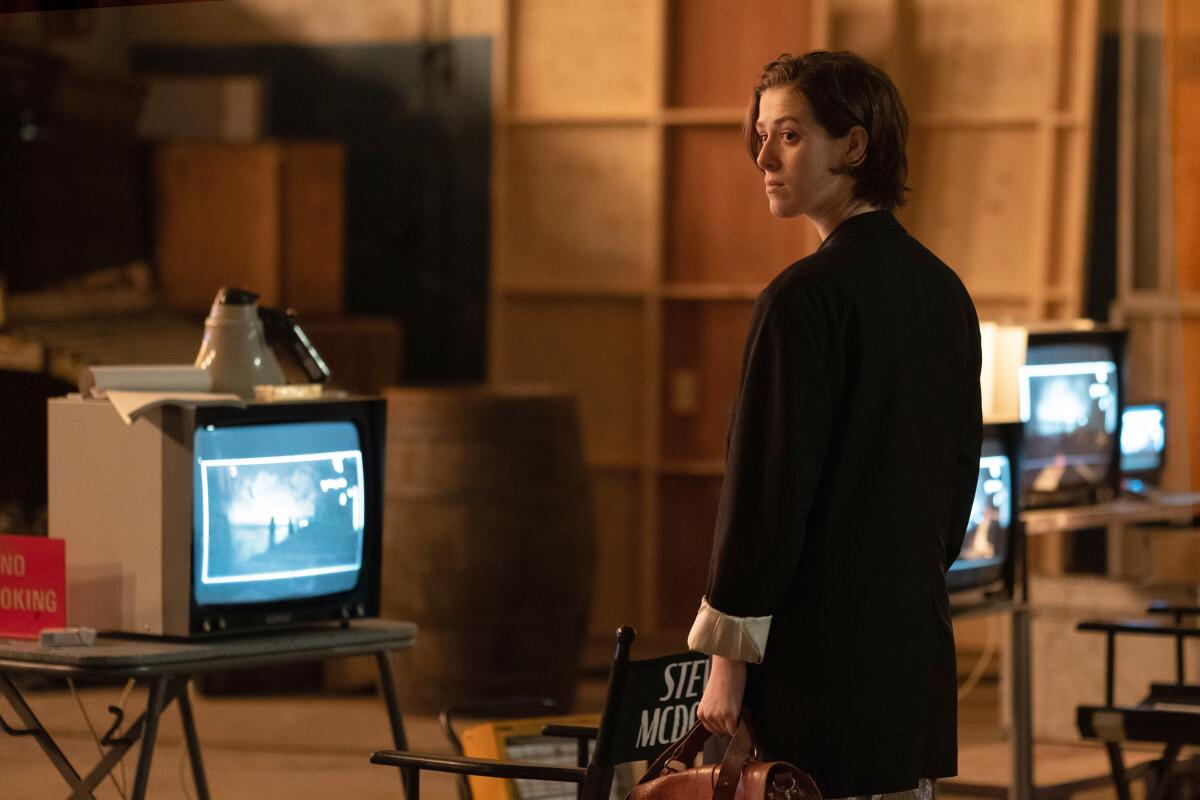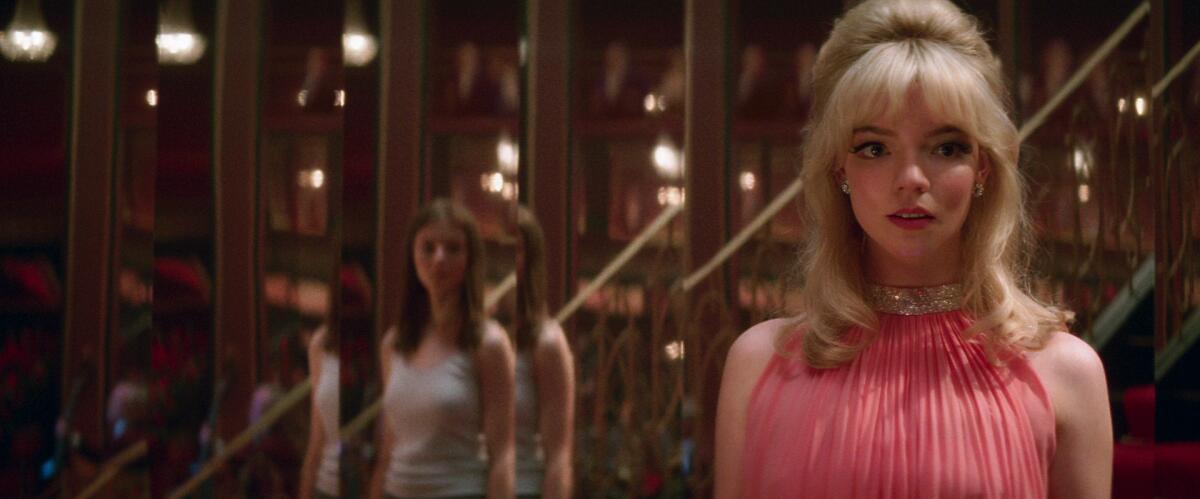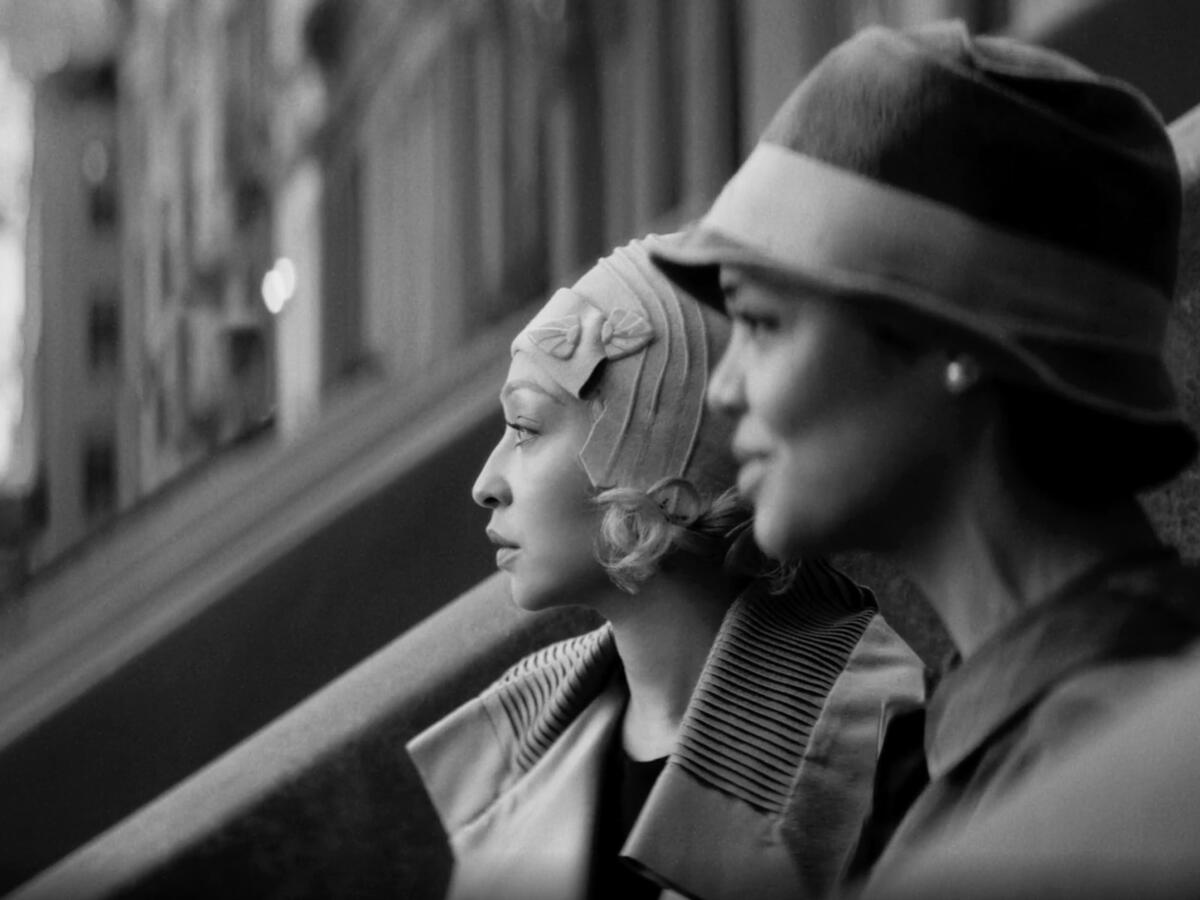Why the year’s best sequel is ‘The Souvenir Part II’
- Share via
Hello! I’m Mark Olsen. Welcome to another edition of your regular field guide to a world of Only Good Movies.
Only good movies
Get the Indie Focus newsletter, Mark Olsen's weekly guide to the world of cinema.
You may occasionally receive promotional content from the Los Angeles Times.
This week saw many, many developments in the story around the shooting death of cinematographer Halyna Hutchins during production of the film “Rust.” The Times’ extensive coverage is all collected here.
On a brighter note, Halloween is this weekend, and it really is a special holiday for movie lovers as a time to celebrate the dark majesty of horror films.
Dawn Burkes, Sonaiya Kelley and Jen Yamato teamed up to compile a list from 25 horror icons, makers and experts on their favorite underrecognized horror films, including picks from Ari Aster, Mike Flanagan, Ernest Dickerson, Tananarive Due, Joe Dante, Barbara Crampton and Cassandra Peterson, a.k.a. Elvira. With info on where to see them all, it makes for a handy viewing list.
Jen also wrote about James Wan’s “Malignant,” which, as she notes, “earned instant cult status among horror fans with its audacious twists, meme-able moments and memorable movie monster — a long-haired boogeyman named Gabriel with a penchant for murder and surprisingly agile parkour skills.”
In an interview from London where he is shooting “Aquaman and the Lost Kingdom,” Wan said, “I hate being pigeonholed. So for me, it was about breaking the expectations that I know people have of me.”
L.A.’s Secret Movie Club is presenting a Halloween-o-thon over the weekend at the historic Million Dollar Theater, including 35 mm screenings of William Castle’s “House on Haunted Hill” and “The Tingler,” Nobuhiko Obayashi’s “House,” David Lynch’s “Twin Peaks: Fire Walk With Me,” John Carpenter’s original 1978 “Halloween” and Sam Raimi’s “Evil Dead 2.”
My own Halloween plans include checking out “The Pentagram of Mexican Cinema Horror Legends,” being presented virtually by CalArts’ REDCAT theater. A performative lecture by film curator and historian Abraham Castillo Flores, it invokes Mexican folklore and the country’s history of fantasy and horror filmmaking.
Also on the 31st, but not really for Halloween, will be an anniversary double feature of Mira Nair’s “Mississippi Masala” at 30 and “Monsoon Wedding” at 20 at the Array Creative Campus, along with a conversation between Nair and Ava DuVernay.
Enjoying this newsletter? Consider subscribing to the Los Angeles Times
Your support helps us deliver the news that matters most. Become a subscriber.
‘The Souvenir Part II’
Directed and written by Joanna Hogg, “The Souvenir Part II” continues the fictionalized exploration of Hogg’s own development as a filmmaker reflected in her experiences while in school, creating a portrait of a young artist. The new film picks up pretty much where the 2019 first film left off, as Julie (Honor Swinton Byrne) is attempting to overcome the drug-overdose death of her lover by channeling her grief into her work as a film student. Tilda Swinton, Swinton Byrne’s mother in real life and a lifelong friend of Hogg’s, again plays Julie’s mother, and Richard Ayoade reprises his scene-stealing role as one of Julie’s classmates. The film is in limited release. (Part 1 is streaming on Amazon Prime and Kanopy.)
For The Times, Justin Chang wrote, “To call ‘The Souvenir Part II’ the best sequel I’ve seen this year — and one of the best movies I’ve seen this year, period — would be both perfectly accurate and wholly inadequate. Something this special deserves more than stock superlatives. … There is no shortage of movies about dealing with loss or movies about making movies, but offhand I can’t recall too many that have braided those strands together as deftly as ‘The Souvenir Part II’ or with such a keen understanding of the stakes and logistics involved. Hogg, looking back at her younger self with an eye both affectionate and unsparing, does not gloss over the possibility that Julie’s ambitions might be misguided at best and doomed at worst.”
For the New York Times, Manohla Dargis wrote, “Movies about moviemaking are rarely as interesting as their makers think, but Julie’s process does illuminate the character and Hogg’s autobiographical intentions. Julie frets, worries, changes her mind, confusing her actors and (understandably) infuriating her cinematographer. … Julie has tapped everything that she has — her images and experiences, her being, seeing, feeling — and in doing so she’s irrevocably blurred the divide between life and art. She lived, made her movie, and will keep on doing both in all the Joanna Hogg movies to come.”
For the Playlist, Carlos Aguilar wrote, “As the two intertwining films progress — the one we are watching and the one being produced in her fiction — the genius nesting doll of profound reflection, false assumptions, and artistic evolution begins to expose themselves. Hogg is projecting within a projection. … An artist at the peak of her creative bravado, Hogg has completed her most astounding work yet. Most compliments will likely fall short of adequately describing its assured prowess. A masterwork of self-introspection through the canvas of cinema, ‘The Souvenir: Part II’ is a meta epic of delicate proportions that constantly folds into itself and reveals the murky waters that border fiction and the reality that inspires it, sometimes, like in this case, more directly than others. That the truth somehow achieves greater veracity when reassessed via fabrication is a spell that only fully breaks when the director yells cut, and perhaps not even then.”
For 4Columns, Melissa Anderson wrote, “As dazzled as I was by the performances in ‘The Souvenir,’ I still responded tepidly to it, largely owing to my impatience with a meek, well-bred female protagonist whose trajectory is largely defined by reacting to someone or something — as was the case with Julie, seduced by a silver-tongued, destructive man all too eager to play teacher and then nearly undone by the crises he instigated. Much of the joy in ‘The Souvenir Part II,’ in contrast, lies in witnessing the once passive, tentative young woman plunge headlong into creative projects, friendships, and romantic dalliances, all the while trying to make sense of the troubled man who had ensorcelled her.”

‘Last Night in Soho’
Directed by Edgar Wright, who co-wrote the screenplay with Krysty Wilson-Cairns, “Last Night in Soho” has the stylish and fun energy of Wright’s other films but with a new depth and darker emotional resonance, playing more as straight psychological horror than the horror-comedy one might expect. Eloise (Thomasin McKenzie) moves to London to study fashion design and is soon haunted by visions of a young woman named Sandie (Anya Taylor-Joy), an aspiring singer in the same London neighborhoods during the mid-’60s. As Eloise is pulled further into Sandie’s world, she begins to lose her grip on reality. The film is in general release.
I spoke to both Wright and Wilson-Cairns about their collaboration on the film for a story that will be publishing soon. Wright’s own voracious appetite for movies is legendary, and he has programmed film series to go along with the film for the BFI, Criterion Channel and Peacock. Yet, as he said of the film’s cinematic references and influences, “I never want people to feel that it is required reading for the film. It’s more the case is, if you enjoyed the film, here’s some more things to delve into. I especially think about it with younger fans who may not be aware of some of the cinema of the ’60s, for example. They may have a couple of titles, and obviously me and you know Antonioni’s ‘Blow-Up,’ but there’s an 18-year-old out there who’s never seen it. And so I’m happy to share like influences and inspirations, whether it be music or film or whatever.”
For Tribune News Service, Katie Walsh wrote, “These dream scenes in which Ellie and Sandie become doubles, seen only in mirrored reflections, are stunning achievements of filmmaking, especially the dizzying configurations of choreography, blocking, editing, and long, swooping camera movements that place Sandie and Ellie in the same shot, whirling across the dance floor, trading places. Park Chan-wook’s longtime cinematographer, Chung-hoon Chung, makes ‘Last Night in Soho,’ without a doubt, the best-looking film of Wright’s career. … This postmodern feminist horror film reimagines an era that objectified women, but as the stakes escalate, the film’s moralities, and loyalties, start to waver. This visual and aural feast does have a stumble or two on the dance floor, though in the 11th hour, Wright manages to right the ship, with an assist from the ever-reliable Taylor-Joy.”
For Slate, Dana Stevens wrote, “There are those who will find the last 20 minutes of ‘Last Night in Soho’ exploitative, ugly, and crude. … Still, there are worse things a male director at mid-career could do than make a movie about women (and co-written by one) for the first time while also experimenting with themes, styles, and subject matter that are entirely new for him. Not every choice he makes in ‘Last Night in Soho’ lands with the rightness of, say, virtually every joke in Wright’s brilliant 2007 cozy-mystery spoof ‘Hot Fuzz.’ But the artists most worth paying attention to are those who leave their early successes behind and seek out new modes of expression — a rejection of nostalgia that, for all of this movie’s affectionate homages and vintage needle drops, is precisely what ‘Last Night in Soho’ is all about.”
For the Guardian, Peter Bradshaw wrote, “The contemporary half of the film is for me less interesting, particularly in the overextended third act. It is almost as if the movie has used up all its horrified rapture on those vivid 1960s hallucinations, and it sometimes isn’t as scary as it could be. McKenzie does a lot of pop-eyed staring and sitting bolt upright in bed as she wakes up from another actually-happening bad dream, and there is a slightly laborious stretch where she is somehow able to research 60s Soho crime from microfiche newspaper records in her college library. In these book-lined stacks she suffers one of many ghost incursions. Taylor-Joy’s Sandie is opaque, but in the right way: the sacrificial fetish in a vortex of fear. None of this stops the Soho of the film from being re-created with great exuberance, a Valhalla of toxic glitz, whose world Wright directs with great style.”

‘Passing’
The feature debut as writer-director for actress Rebecca Hall, “Passing” was adapted from Nella Larsen’s 1929 novel of the same name. Two childhood friends, Irene (Tessa Thompson) and Clare (Ruth Negga), both mixed-race, reunite as adults. Clare has taken to passing for white, while Irene is the wife of a prominent Black doctor, creating a dizzying world between them of race, identity and desire. With remarkable performances by Thompson and Negga, the film is in limited release and begins streaming Nov. 10 on Netflix.
For The Times, Justin Chang wrote, “‘We’re all of us passing for something or other, aren’t we?’ Irene wonders in one of the script’s few nudge-nudge lines, though it does raise the intriguing possibility that ‘Passing’ might itself be passing for something else. You start to wonder if the movie’s ostensible subject, the complexities and contradictions of racial identity, might in fact be something of a smokescreen — a provocative point of entry into a story rippling with more generalized undercurrents of jealousy, fear and discontent. … ‘Passing’ ends with the shock and sorrow that have been foreshadowed from the beginning, but also with a kind of puzzlement, a sense of disquiet. It’s a beautifully chiseled vision of an uglier world, an artifact of a vanished reality that you’re grateful — and yet strangely reluctant — to leave behind.”
Sonaiya Kelley spoke to Hall, Thompson and Negga when the film premiered at Sundance earlier this year and will be publishing a profile on Negga soon. As Negga said at the time, “What’s interesting about this book is that we’re all so very much affected by how other people see us or perceive us. I think when you’re a kid it’s very hard to understand the impact it has on you. For me, I felt like it was very important not to be treated like flotsam and jetsam on somebody else’s wave of interpretation of who I am. And it was very important for me to seek identity in art and literature. I think it spurred my interest in the arts because I think that’s where we see ourselves reflected.”
For RogerEbert.com, Odie Henderson wrote, “This is a deliberately paced film with enveloping moods that feel like symphony movements. There’s heavy material here, but ‘Passing’ doesn’t belabor its points. When Brian rightfully tries to warn his sons about the racist trouble they’ll face in the world, Irene argues that they should have some innocence in their youth. We understand both arguments even though we know one of them is very, very naïve. The entire film exists in this perpetual state of a deceptively gentle push and pull. It’s a masterful balance of tone. And even though we anticipate the ending, it comes with a surprising amount of empathy and sadness, two things that were always subtly present during the runtime.”
For the Playlist, Robert Daniels wrote, “‘Passing’ will catch many a viewer flat-footed. But the rarity of glacially paced Black lesbian period pieces means ‘Passing’ is worth repeat viewings just to catch its string of minute calibrations — especially the delicate way Thompson and Negga dance in armed emotional landmines. … At its core, ‘Passing’ is about safety and comfort. The comfort unoffered to Black men during the ’20s. The solace denied to not just gay women, but Black lesbian women. The film’s shocking conclusion hides the offending hand. Is racism the culprit or the survivalist instincts born into oppressed people to hold on to their hard-earned comforts? With an incredible ensemble and an elegant eye, Hall’s ‘Passing’ is a high-wire act of a debut that tackles its several thorny issues with nary a scratch.”
For Essence, Rebecca Carroll wrote, “From a purely aesthetic standpoint, the film, shot in black and white, is an elegantly textured, rigorously restrained masterpiece. … Among the film’s most affecting achievements is how Hall captures the stubbornly trenchant, rage-inducing frivolity of racism that seethes below the surface before exploding with casual indifference.”

Only good movies
Get the Indie Focus newsletter, Mark Olsen's weekly guide to the world of cinema.
You may occasionally receive promotional content from the Los Angeles Times.




